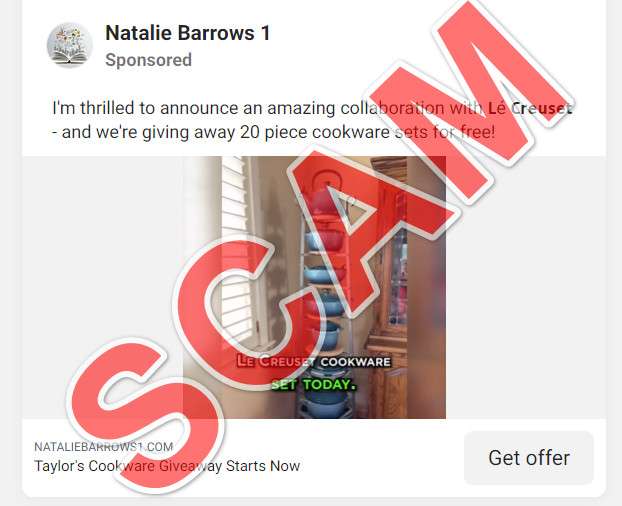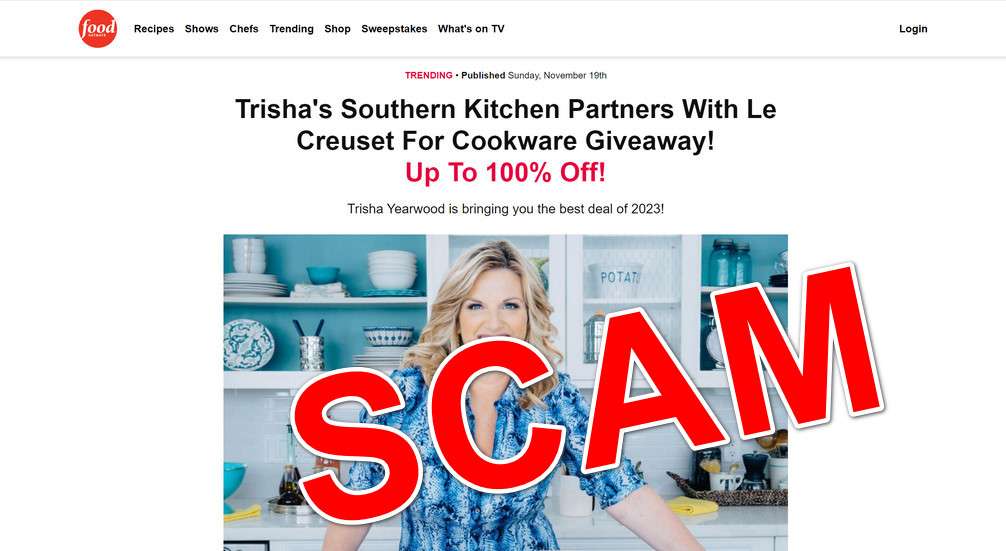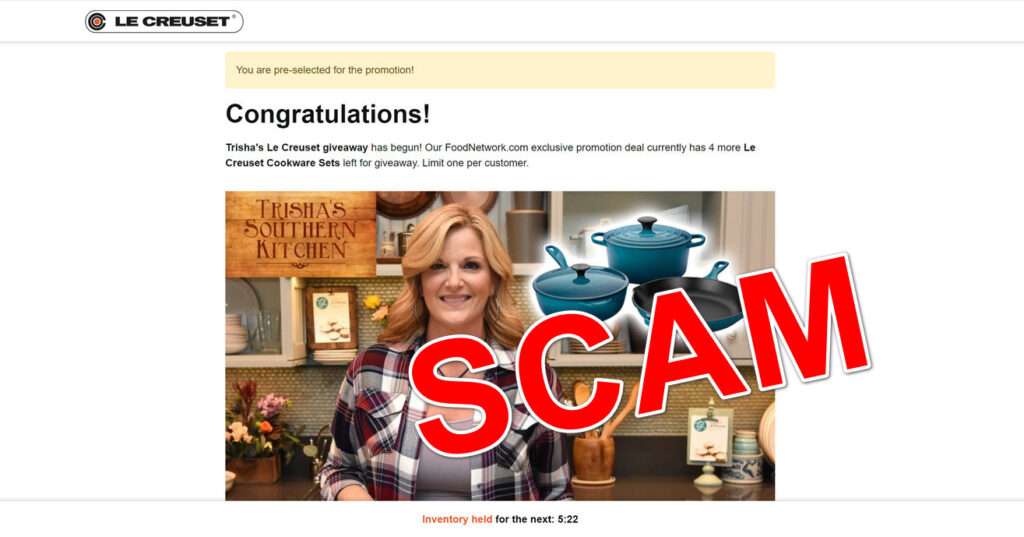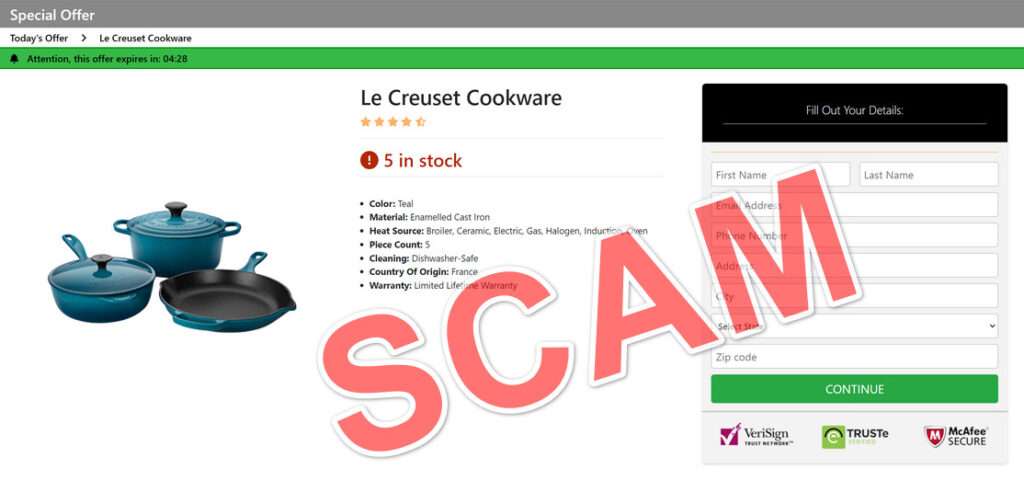An exploding new scam on social media platforms is using deepfake videos of celebrities like Lainey Wilson, Ree Drummond, Taylor Swift, Oprah, Trisha Yearwood, and Martha Stewart to fool users into handing over their money. These fake promotions claim the stars are giving away free Le Creuset cookware worth hundreds of dollars due to a supposed excess inventory. However, the entire thing is an elaborate hoax aimed at stealing personal information and forcing hidden subscription charges.
This article provides an in-depth examination of how the celebrity Le Creuset giveaway scam works, the manipulation tactics used, who’s behind it, and most importantly, how to protect yourself online. In the modern digital landscape, it’s more vital than ever to be an informed consumer and identify frauds like this attempting to capitalize on fake celebrity endorsements. Keep reading to learn the tactics scammers use and make sure you don’t fall for this malicious scam.




This Article Contains:
Overview of the Celebrity Le Creuset Giveaway Scam
The celebrity Le Creuset giveaway scam operates by promoting fake promotions on Facebook, Instagram, TikTok, YouTube, and other social platforms using deepfake videos and sponsored posts. The ads feature realistic-looking videos of various celebrities announcing they have excess Le Creuset inventory so they’re giving it away for free to fans.

Some of the stars being impersonated include:
- Lainey Wilson
- Ree Drummond
- Taylor Swift
- Oprah
- Jennifer Lopez
- Trisha Yearwood
- Martha Stewart
The deepfake videos are created using advanced artificial intelligence to closely match everything from the celebrity’s voice, facial expressions, and speech patterns. This lends credibility so users believe the stars are genuinely endorsing a free Le Creuset giveaway.
When social media users click on these ads, they’re taken to elaborate fake news websites made to look like MSN, Buzzfeed, People Magazine, and more. The fake articles promise users can receive expensive Le Creuset cookware or bakeware sets completely free, with just a small $10 shipping fee.
In reality, this is a front to obtain credit card information and unknowingly register people for an expensive monthly subscription they didn’t agree to. The scammers bank on the legitimacy of celebrity names and urgency of limited-time offers to trick victims into handing over their money and personal data.
Breakdown of the Scam Process
Here is a step-by-step breakdown of how the celebrity Le Creuset giveaway scam operates at each stage:
- Scammers create fake social media ads using deepfake videos of celebrities urgently announcing free Le Creuset giveaways. The AI-generated videos appear very real and convincing.
- When users click on these sponsored posts, they are sent to elaborate fake news articles promising free Le Creuset products for a small shipping fee of around $10.
- Excited users provide their personal and payment information to claim their “free” cookware set and cover shipping costs.
- But users are actually subscribing to a recurring monthly fee they aren’t made aware of. Initial charges of $89+ hit their cards within days.
- The monthly fraudulent charges continue indefinitely until users spot the activity and cancel. Victims never receive any free products.
- Bogus “customer service” contacts pretend charges were agreed to, refuse refunds, and use other shady tactics.
As you can see, this scam relies entirely on fabricating celebrity affiliations, disguising monthly fees, and pressuring users to act fast before the invented limited-time promotion expires.
Detailed Breakdown of the Scam Process
To fully understand how this widespread scam works and identify red flags, here is a more in-depth walkthrough of the step-by-step process:
Step 1 – Fake Social Media Ads
The scam begins with promoted ads run on social platforms like Instagram, Facebook, YouTube, and TikTok. The ads include video clips apparently showing various celebrities casually speaking directly to the camera/audience.
Thanks to advancements in deepfake technology, the videos appear incredibly realistic. The celebrity’s face, voice, mannerisms, and speech patterns are cloned almost flawlessly by the AI software. Absolutely nothing visually or audibly signals the videos are counterfeit.

In the forged videos, the celebrity explains they’re urgently giving away free Le Creuset products because of excess inventory they need to get rid of. Specific details include:
- A limited-edition product collaboration with Le Creuset resulted in “thousands of excess sets” sitting in warehouses.
- Rather than letting the expensive cookware go to waste, they’ve decided to generously give sets away to loyal fans who act fast.
- Sets are available on a first come, first served basis until the leftover stock sells out.
Urgency and exclusivity tactics like this encourage social media users to immediately click through and claim the purported free products.
Step 2 – Fake News Websites
When people click on the promo ads, they are redirected to pseudo news articles that appear at first glance to be from legitimate publications like People Magazine, Buzzfeed, and major news networks. However, the sites are complete fakes.

While cleverly designed, closer inspection reveals multiple red flags, including:
- Incorrect website URLs (ex. “Peopel.com” vs People.com).
- Amateur site formatting, logos, fonts, and stock imagery.
- Missing contact pages, sloppy text, broken navigation links.
- No links or mentions of any real writer/journalist at the site.
- No actual social media profiles associated with the fraudulent domain.
The goal is tricking users into trusting the false information and celebrity endorsements being presented in the articles.
These fake news stories provide additional background on the supposed excess Le Creuset inventory prompting the urgent giveaways. They include convincing quotes from the celebrities expressing excitement for fans to score free cookware thanks to the special product collaboration. Of course, all quotes are invented for the scam.
The articles emphasize readers must act fast to claim their free sets before the limited supply is gone. A sense of urgency pushes victims to provide their information without deeper scrutiny that would reveal the scam.
Near the bottom of the page, a prominent “Claim Yours Now!” button is presented along with text stating readers can obtain their free Le Creuset items with just a small $9.95 shipping and processing fee. In reality, this modest charge is a front for illegitimate recurring subscriptions being applied to user accounts without consent.
Step 3 – Submit Personal and Payment Information
When users click the “Claim Yours Now!” CTA buttons eager to score expensive free Le Creuset products, they are redirected to an online order form on a third-party website unaffiliated with any of the celebrities or brands involved.
These fake promotion sites have vague names like “OnlineProductOffers”, “LimitedTimeGiveaways” or “DealsZone”. They continue the ruse by using Le Creuset branding and imagery along with urgent messaging about limited supply.

To finalize the order for their “free” items, users must fill out personal details including:
- Full Name
- Physical Address
- Email Address
- Phone Number
They then must enter credit/debit card payment information so the $9.95 shipping costs can be processed to deliver the free products.
An additional checkbox has users “agree” that they understand the single $9.95 charge to cover shipping and handling. Nowhere on the page is it revealed this activates an ongoing monthly subscription. That critical detail is buried deep in lengthy terms and conditions, knowing most people won’t read the fine print.
As soon as users submit their info, their payment method is automatically enrolled in expensive recurring subscription charges without any further consent.
Step 4 – Monthly Subscription Charges Begin
Within 3-5 days of providing payment details, victims will experience the first fraudulent subscription withdrawal from their account for amounts like $89.95 or $99.95. These excessive fees are wholly unrelated to any supposed shipping charge.
The shady websites apply monthly subscriptions using the collected user data and payment methods. The excessive monthly charges will continue indefinitely until identified and cancelled. Of course, users never receive any free Le Creuset products as promised initially.
Step 5 – Fake Customer Service if You Complain
When defrauded users eventually notice the unauthorized activity on their accounts and contact customer service to complain, they experience more deception and stonewalling. The fraudsters operating the sites insist the monthly fees were clearly agreed to in initial fine print terms.
Their tactics include:
- Citing unrelated terms & conditions users “signed” as consent to recurring billing.
- Claiming the monthly fee is for unused free trial offers on other sites in a network users accessed.
- Placing victims on endless holds then disconnecting the call to avoid issuing refunds.
- Outright refusing refunds and threatening legal action or penalties for “violating” terms.
In the end, almost no users are able to recover lost funds or cancel these celebrity giveaway scams once their payment information has been compromised. The entire system is constructed to mislead at every stage.
Recognizing Red Flags of the Scam
Now that you understand the step-by-step workings of the celebrity Le Creuset giveaway scam, here are key signs to recognize as potential red flags when encountering questionable offers online:
- Too good to be true – Free luxury products and massive discounts are always a red flag signaling a potential scam attempt. Real prizes or freebies are never brand new expensive merchandise like Le Creuset cookware.
- Aggressive sales tactics – Pressuring language about “limited sets” or “act fast before it’s gone!” should be viewed cautiously. Scammers create false urgency to get users to hand over payment info and bypass scrutiny.
- Poor quality websites – Fake promotion pages and news sites feature amateur design, weird URLs, bad grammar and spelling. Real publications value quality writing and design.
- Celebrity endorsements – It’s highly suspicious for celebrities to endorse random free giveaways on social media ads. Legit partnerships are announced officially on their real websites and social profiles.
- Requests for sensitive information – Why would a free cookware offer need your SSN or bank login credentials? Only scammers ask for more personal info than reasonably needed.
- Hidden terms and conditions – If an offer is free and being endorsed publicly, terms governing charges will be stated clearly. Scams bury dubious recurring fees deep in fine print intentionally.
Stay skeptical whenever you see urgent limited-time promotions, celebrity endorsements imploring you to act fast on social media, and legal jargon downplaying otherwise hidden costs. If an offer arouses suspicion, trust your judgement and avoid providing personal or payment details until legitimacy can be confirmed.
How to Spot the Scam on Facebook on Social Media
How to Spot the Scam on Facebook
The celebrity Le Creuset giveaway scam is promoted heavily on Facebook. Here’s what to watch for:
- Video ads in feeds using deepfakes of celebrities announcing the urgent giveaways. The AI-faked videos will closely match their look, voice and mannerisms.
- Posts urging users to claim the exclusive free offer before leftover inventory is gone. Scams use false scarcity.
- Comments with generic excitement about the promotion to build legitimacy. These are usually bots and fake accounts.
- Wrong domain names (ex. Facbook instead of Facebook) in page URLs pointing to fake news sites.
- Links to sketchy websites unaffiliated with the celebrity or Le Creuset in any way.
If you see these signs, report the content immediately. Do not engage or click on links as it could compromise your personal information with scammers.
How to Spot the Scam on Instagram
Here are red flags the celebrity Le Creuset giveaway scam is promoted on Instagram:
- Targeted sponsored posts in your feeds using deepfake celebrity videos announcing the promotion.
- Captions emphasizing a limited-time offer and urgency to act fast. Scammers create false urgency.
- Comments from fake bot accounts expressing excitement. Real users won’t engage much with scam posts.
- Accounts pretending affiliation with celebrities by using their images, but having unrelated usernames.
- Bio links pointing to fake landing pages/websites unassociated with the celebrity or brand.
Avoid sponsored celebrity giveaway promotions on Instagram. Report them as scam attempts to get the content removed ASAP.
How to Spot the Scam on TikTok
Here are signs the celebrity Le Creuset giveaway scam is being promoted on TikTok:
- Video ads between feeds using deepfakes of celebrities announcing free Le Creuset due to excess inventory.
- Highly suspicious view counts, likes, and comments from bots making it appear popular.
- Urgency tactics in captions warning to act before the fake limited-supply is gone.
- Links in bios redirecting to completely fake news websites.
- Comment sections with obvious bot accounts praising the too-good-to-be-true promotion.
Never click on links from strangers on TikTok, especially involving celebrity endorsements of expensive free products. Report suspicious promoted giveaways immediately.
What to Do if You Fell Victim to the Scam
If you entered any sensitive information or payment details in relation to a free celebrity Le Creuset promotion, here are the steps to take right away in attempting to address the situation:
Step 1: Contact Your Bank
Call your credit card company or bank immediately to report being scammed into an unwanted recurring subscription. Ask them to block any future associated charges. See if any fraudulent fees can be reversed or refunded depending on how long ago entered. Acting quickly is key for the best outcome. Provide transaction dates and merchant details.
Step 2: Cancel Any Accounts Created
If you created accounts on related scam websites, login and permanently delete or deactivate them. This removes stored payment data from their records, preventing continued billing. Also unsubscribe from any emails you may have signed up for in the process by clicking “opt-out” or “unsubscribe” links at the bottom.
Step 3: Change Exposed Passwords
Change any passwords you used on the fake promotion sites ASAP if they’re used elsewhere. Scammers can exploit password reuse to access more of your accounts. Enable two-factor authentication for additional security on sensitive logins.
Step 4: Watch for Other Suspicious Charges
Carefully monitor bank statements, credit reports, and all connected accounts over the next few months for any other unusual or unauthorized charges. Since scammers trade stolen information online, one scam can lead to more fraud down the line. Report any dubious activities immediately.
Step 5: Report the Scam
To help get scam sites shut down faster, file details of your experience with:
- Federal Trade Commission
- Consumer Financial Protection Bureau
- FBI Anti-Fraud Division
- Social Networks the ads appeared on
- Le Creuset security team
- Local police fraud department
Reporting scams reduces this content’s reach, preventing more victims.
Frequently Asked Questions about the Celebrity Le Creuset Giveaway Scam
What is the celebrity Le Creuset giveaway scam?
This is a fraudulent social media scam using deepfake videos of stars like Lainey Wilson, Ree Drummond, Taylor Swift, Oprah, Trisha Yearwood, and Martha Stewart announcing free Le Creuset giveaways. The fake promotions promise free cookware but instead force hidden monthly subscription fees on victims.
How are they faking celebrity endorsements?
Scammers use advanced deepfake technology to create realistic videos of celebrities that closely match their face, voice, speech patterns, and mannerisms. This tricks viewers into thinking the stars genuinely endorsed the promotions.
What tactics does the scam use?
Tactics include deepfake videos, fake urgency around limited-time offers, elaborate fake news websites, fine print concealing monthly fees, and refusal to issue refunds through deceptive “customer service” contacts.
What are the costs victims incur?
Users believing they will receive free Le Creuset products provide their information and a small $9.95 “shipping” payment. But within days, charges of $89+ from an unauthorized monthly subscription hit their accounts instead.
What should I do if I shared my information?
Immediately call your bank to dispute the charges, cancel any accounts created on scam websites, monitor your statements for further fraud, change exposed passwords, and report the scam details to authorities and consumer protection agencies.
How can I recognize similar celebrity endorsement scams?
Look for social media ads and websites urgently promoting free gifts or products using celebrity names, images, and videos. Especially beware of limited-time offers requiring upfront payment info. Verify authenticity directly on real brand sites before providing any data.
How can I protect myself from these scams?
Stay skeptical of social ads and websites promoting free high-ticket items from celebrities. Check URL spellings and quality of websites before entering info. Read all terms and conditions closely to identify recurring fees. Monitor accounts after providing payment details anywhere online.
Where should I report celebrity endorsement scams?
Report scam promotions to social media security teams, brand security departments, the FTC, BBB, IC3, and your local authorities. Reporting gets scam content removed faster to prevent more victims.
Are the celebrities involved in the scam promotions?
No, the celebrity names, images, and deepfake videos are used completely without their consent. The scammers do this solely to deceitfully gain trust and trick users into providing their payment information.
The Bottom Line on Avoiding the Scam
The celebrity Le Creuset giveaway scam preys on trusting social media users through deceptive ads, websites, and deepfake videos falsely claiming to offer free high-ticket products. But knowing what red flags to watch for makes it possible to identify and avoid.
Here are key tips for staying safer online moving forward:
- Act cautiously regarding giveaways for expensive new merchandise and celebrity endorsements on social ads.
- Be wary of high-pressure urgency tactics and exaggerated limited-time claims.
- Verify legitimacy of promotions on real brand websites before providing personal or payment data.
- Read all terms and fine print closely to identify hidden subscription costs before entering payment info.
- Report suspicious activities, ads, accounts and charges to authorities to get scams shut down faster.
Staying vigilant against fraud protects not only yourself, but others who may encounter risky offers promoted online or on social platforms. Share this guide to help more users avoid the celebrity Le Creuset cookware giveaway scam!










